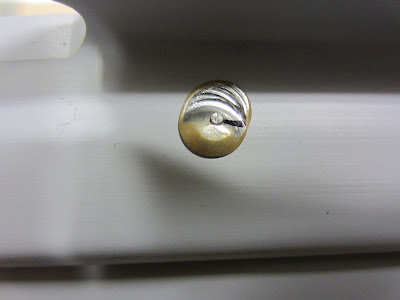As I said I was going to do earlier, I pulled the rudder counterbalance (CB) skin off and tried to tweak a few things, mainly the ribs, to get the holes to line up a little better than they were. I finally succeeded with that.
 |
| Working with the CB Skin Ribs to Get a Better Fit |
So, once I had things back together, I match drilled the skin to the rib holes with a #40. Next up was to cleco the rudder skins to the ribs and spar assembly. Also, make sure you file the area of the split of the rudder skin to fit around the rudder horn. This isn't called out anywhere but just assumed. I made sure to have at least a 1/32"-1/16" gap on either side.
 |
| Rudder Skins Attached, Ready for #40 Drilling |
 |
| Fitting the Skin to Fit Around the Rudder Horn |
After that, I inserted the AEX R-916 rudder trailing edge between the skins and cleco'd in place then drilled all the holes in the rudder to size. Make sure you have your AEX piece in place the correct way. I've seen where builders have put it in place with the "V" facing AFT, only to realize it's in backward after drilling. Next, I marked, cut and trimmed the R-710 rudder brace. You have to cut off a bit on both sides of the piece for it to fit in the bottom spar.
 |
| Rudder Brace - Cut, Cleaned and Ready To Go! |
Once cut and cleaned, I inserted it between the R-405 PD rudder horn and the R-904 bottom spar. Cleco it in place and then first match drill the aft holes to #30 then move to the forward holes and match drill.
 |
| Rudder Horn In Place, Ready for Match Drilling |
I then took a 36" piece of .032 aluminum from the parts inventory and cut it into 2 pieces and fabricated the R-918 rudder bottom attachment strips per the plans and drawing. They have you clamp the pieces in place and measure on your own as to where it should be attaced. I made sure mainly to keep the aft hole in from the end of the pieces by 1/4" so you have enough edge spacing for your rivets to set correctly. I also made sure to not run the strip into the bend of the rib flange. That said, my measurement came to be 9/16" from the bottom of the skin to the bottom of the strip and 1/4" from the aft end of the strip to the aft edge of the last hole in the skin. Confused? It's pretty easy. I can clarify in an e-mail if you'd like. The third picture better illustrates the discussion.
 |
| Rudder Bottom Attachment Strips |
 |
| Attachment Strips After Clamping. Drill As You Go, Inserting Clecos Along the Way. |
 |
| Rudder Attachment Strip Marked 1/4" from end |
Once the strips are in place, I match drilled to a #40 then disassembled the whole kit and kaboodle. Deburr all the holes then dimple the skin, spar and ribs. I haven't done any dimpling as I'm still deburring and cleaning edges. Oh, the plans don't mention anywhere to match drill the reinforcement plates. While disassemblilng, I realized this and took care of that with a #30 before removing the clecos.
 |
| Spar Reinforcement Plates - Don't Forget to Match Drill Before Disassembly |
 |
| Rudder Disassembled - Ready for Deburr, Edging Breaking, ScotchBrite and Cleaning |
 |
| Lather, Rinse Repeat..... |
Sunday, July 22 - 4.6 hrs
HOBBS Meter - 76.3 hrs
Tonight I finished deburring. Wednesday, July 25 - .5 hrs
Thursday, July 26 - Tonight, I started dimpling and edge cleaning all parts. I haven't dimpled the rudder skins yet, except for the CB skin. I stopped when I got to the tip rib where I don't have the correct tools to dimple the last few holes. I've read where most builders get stuck here. I ordered a set of 3/32" dimple dies from Avery on a set of Vice Grips. That seems to be the way to go after quite a bit of research. You'll have to bend the flanges out of the way a bit to get to them cleanly then bend them back. Only slightly so as not to create fatigue in that area. Their inventory shows "Out Of Stock". In the meantime, I'll finish dimpling the skins and maybe move on to the next sub-assembly. I do have some rearranging in the garage to tackle so I can get my wing parts out of their crates and up on shelving units. In addition, I need to get ready to build the wing jigs which will mount from the floor to the ceiling and extend from near the rollup door back to a little longer than the length of the wings. That'll be a fun little project. That's it for now. Take Care and Thanks For Reading!
HOBBS Meter - 77.4 hrs.








































